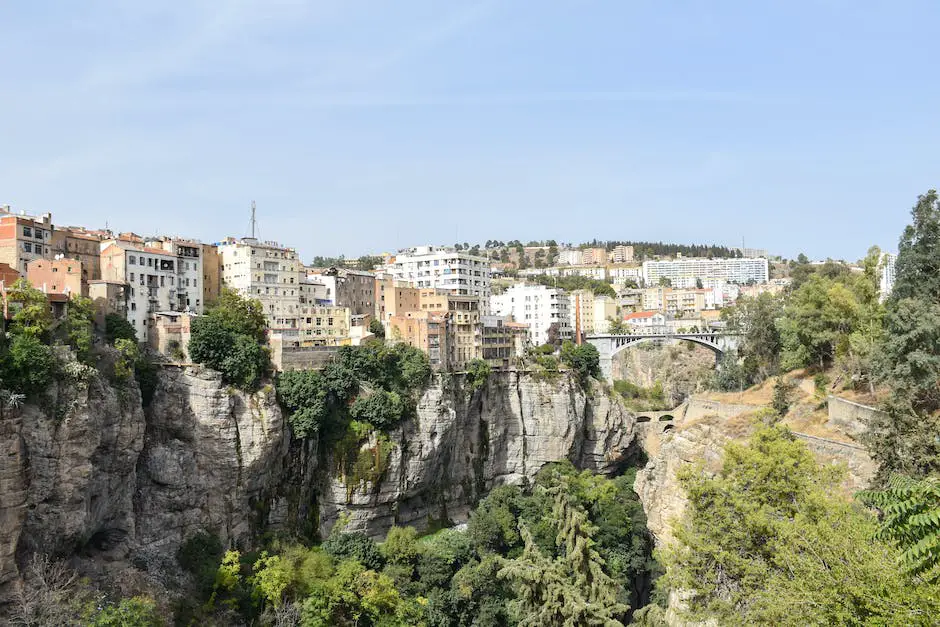
Nestled in the rugged landscape of Algeria, Constantine, often referred to as the “City of Bridges,” boasts a rich tapestry of architectural marvels that tell tales of its storied past. As I meander through the city’s winding streets and gaze upon the ancient structures, I can’t help but feel transported through time. The city’s architecture is a palimpsest, with layers of history etched into every stone.
The evolution of Constantine’s architecture is a fascinating journey through various epochs, each leaving its indelible mark. From the Phoenician and Roman influences to the Ottoman and French colonial periods, the city’s buildings are a mosaic of cultural imprints.
One of the most iconic elements of Constantine’s architectural heritage is its parks, where the fusion of natural beauty and human ingenuity is on full display. The verdant spaces amidst the urban sprawl are not just for leisure but also serve as a canvas for architectural expression.
The Phoenician and Roman Footprints
Constantine’s story begins with the Phoenicians, who laid the city’s earliest foundations. However, it was the Romans who truly transformed it into a metropolis of grandeur. The remnants of Roman architecture, like the majestic aqueducts and bridges, still stand as a testament to their engineering prowess. These structures were not just functional; they were designed to impress and proclaim the might of the Roman Empire.
The Islamic Influence
With the spread of Islam, Constantine saw an architectural revolution. The introduction of mosques and palaces brought a new aesthetic to the city. The Great Mosque of Constantine, with its intricate tile work and arabesque patterns, is a prime example. It’s a place where spirituality and artistry converge, creating a serene atmosphere that’s almost palpable.
The Ottoman and French Colonial Eras
The Ottoman period introduced yet another layer, with the construction of the Souq al-Ghezel (the Wool Market) and the Palace of Ahmed Bey. These structures showcased the opulence and sophistication of Ottoman architecture. Then came the French colonialists, who left behind a wealth of Beaux-Arts buildings, adding a European flair to the city’s skyline.
Modern Times and Beyond
In recent years, Constantine has embraced modernity while respecting its past. Contemporary buildings stand shoulder to shoulder with ancient ones, creating a dialogue between the old and the new. The city’s commitment to preserving its heritage while forging ahead is evident in its urban planning and architectural choices.
Constantine’s Parks: A Blend of Nature and Architecture
Constantine’s parks are a microcosm of the city’s architectural journey. Take, for instance, the Emir Abdelkader Park. It’s not just a green oasis; it’s a space where history and modernity coalesce. The park’s design pays homage to the city’s multifaceted architectural heritage while providing a contemporary space for relaxation and socialization.
FAQs
- What are some must-see architectural sites in Constantine?
Visitors should not miss the Palace of Ahmed Bey, the Great Mosque, the Roman bridges, and the French colonial buildings in the city center.
- How has Constantine’s architecture influenced modern design?
Modern architects in Constantine often draw inspiration from the city’s historical motifs and integrate them into contemporary designs, creating a unique blend of old and new.
- Can you explore Constantine’s architecture through its parks?
Absolutely! The city’s parks offer a glimpse into its architectural evolution, with elements from different eras harmoniously integrated into these public spaces.
Conclusion
In conclusion, Constantine’s architecture is a rich tapestry that narrates the city’s history. From the ancient Roman bridges to the serene parks like Emir Abdelkader, each structure tells a story of cultural exchange and evolution. As we’ve explored, the city’s architectural heritage is not just preserved in its monuments but also in its living spaces, where the past and present merge seamlessly. For those seeking to understand the essence of Constantine, its architecture is a compelling guide.
Whether you’re a history buff, an architecture enthusiast, or simply someone who appreciates beauty, Constantine’s parks and buildings offer a window into a world where various epochs coexist. It’s a place where every corner holds a surprise, and every structure has a narrative. So, if you’re ever in Algeria, make sure to witness the architectural splendor of Constantine—it’s an experience that will stay with you long after you’ve left its storied streets.